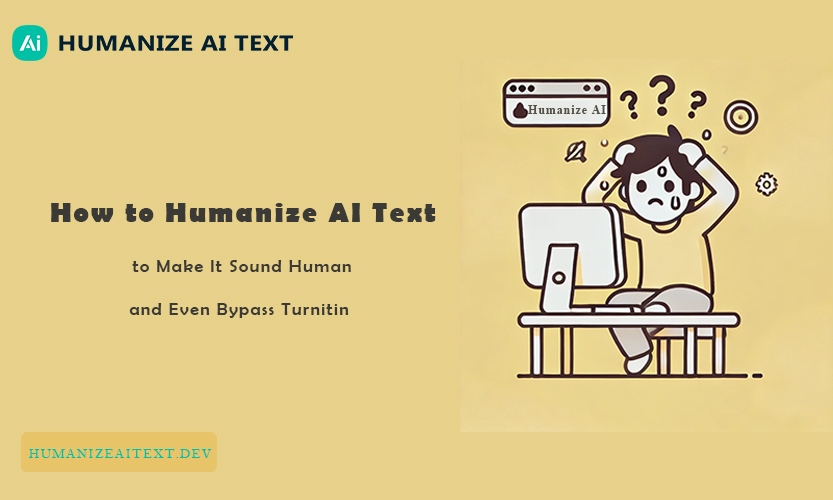Let’s be honest – AI writing is far from perfect. While tools like GPT can churn out content quickly, they often lack the natural flow. Worse, students and professionals alike are running into issues with plagiarism detection tools like Turnitin flagging AI-generated content as “inauthentic.”
In this article, we’ll look at 9 common methods, including AI text humanizers, to help make the text produced by ChatGPT or other AI writing tools sound more human.
#1 Humanize AI Text with an AI Humanizer: The Most Effective Way to Get High Human Score
Sometimes, no matter how you tweak your prompts or edit the output, the text generated by ChatGPT can still get flagged by AI detection tools. When that happens, the only real solution is to rewrite the content from scratch.
However, doing this manually can be really tedious and time-consuming, which kind of defeats the purpose of using ChatGPT in the first place. A better approach is to use an AI-based tool that can help you get past these detection systems.
HumanizeAIText is designed specifically for this purpose. It uses advanced natural language processing algorithms to make AI-generated content sound more human. This way, it removes typical AI writing traits and helps ensure that the output goes undetected by AI checkers like Turnitin and GPT-0.
Real Examples: Before and After Using HumanizeAIText
We generated a text from GPT and ran it through the HumanizeAIText tools. Look what happened:
Before:
“Nestled among the eucalyptus trees of Australia, koalas stand as one of nature’s most endearing symbols of wildlife. These furry marsupials, often mistakenly referred to as “koala bears,” are not only beloved for their unique appearance but also hold a vital role in their ecosystem. Known for their slow, tranquil lifestyle and exclusive diet of eucalyptus leaves, koalas captivate the imagination of people worldwide. “

After Using HumanizeAIText:

“Australian koala has its unique status as a wildlife icon of the nature reserve located in Australia. The bluish-gray arboreal herbivore, for some reason, the so-called “koala bear,” is a popular animal in many areas especially due to its exotic appearance as well as their contribution to the population of Australia. They are associated with their theme for a slow and quiet lifestyle as well as an-all-exclusive menu of eucalyptus leaves, which give them the chance to be adored by people all over the map.”
Now, we’ve put this output through mainstream AI detection tools to see how it scores on human versus AI detection:



Other Methods to Humanize AI Text
Use AI Humanizer like HumanizeAIText is the fastest and most reliable way to create natural text while bypassing AI detectors. For more ways how to not get caught using AI writing tools like ChatGPT, find out more below:
#2 Humanize AI Text: Use Thought-Provoking Prompts
The secret to natural-sounding AI output starts with a good prompt. Avoid generic instructions like “Write an article about X.” Instead:
Specify tone and audience: “Write informally, as if explaining to a curious teenager.”
Assign personas: “Pretend you’re a seasoned journalist covering this topic.”
As you can see, specific prompts guide AI to create content with a specific personality and friendly tone. However, this is just the starting point; there are some more adjustments needed for authenticity.
#3 Use Paraphrasing Tools
In addition to our AI humanizer tool mentioned earlier, paraphrasing tools like Quillbot or CleverSpinner can be utilized in humanizing AI-generated content by rewriting the sentence structure and words in a way that patterns become difficult to identify.
Example:
Original from ChatGTP: “AI is transforming industries at a rapid pace.”
Paraphrased: “The impact of AI on industries is growing at a higher pace than before.”
Tip: Proofread the output for coherence and tone consistency always.
#4 Evoke Emotional Responses to Humanize AI Text
AI often struggles to convey emotion authentically. Injecting feelings like empathy, excitement, or humor can humanize your text:
Instead of: “AI is beneficial in many fields,” try: “Imagine a world where AI makes your life easier every day—that’s what we’re heading toward.”
Emotive language makes messages more relatable, therefore, helping to generate traction.
#5 Less Repetition
AI tends to repeat phrases and structures, making the results feel robotic. Keeping this in mind, below methods to humanize AI text worth trying:
- Mix up sentence lengths and structures.
- Avoid overused words like “important”.
- Swap formulaic transitions like “In conclusion” with unique phrases like “To wrap it up” or “Putting it all together.”
#6 Increase Complexity and Diversity
Perplexity (writing complexity) and burstiness (sentence variety) are key indicators of human writing. To improve these:
- Use a mix of short, punchy sentences and longer, intricate ones.
- Introduce advanced vocabulary or rhetorical devices.
For example:
Basic: “AI is changing the world.”
Enhanced: “AI’s transformative impact on global industries is reshaping the way we think about innovation.”
#7 Adopt Specific Perspectives
AI-generated content often feels generic, so try to adding a distinct viewpoint – whether personal, professional, or anecdotal – makes it more relatable and less detectable as AI-generated:
Example: “As a small business owner, I’ve seen firsthand how AI streamlines operations.”
#8 Insert Disfluencies
Human speech often includes disfluencies like “um,” “uh,” and self-corrections, which are actual representations of thinking patterns. So, including these disfluencies in AI-written text can make it sound natural and less computer-like.
For example:
AI: “This technology is useful in all industries.”
Humanized: “This technology is, um, really useful in a lot of industries.”
Evidently, the latter humanized sentence is a more accurate representation of natural speech.
However, it’s essential to use this technique judiciously to avoid compromising clarity and professionalism.
#9 Introduce Human Errors (If Appropriate)
Intentional typos or grammatical mistakes can mimic human imperfection, fooling AI detectors:
“It’s a great day” instead of “It’s a great day.”
This method should only be used in informal contexts, as it can detract from professionalism.
Why Humanizing AI Text Matters?
As AI-generated content becomes more prevalent, many users wonder whether it’s truly necessary to “humanize” the text produced by tools like ChatGPT. Why would we even want to tamper with something computers can accomplish with precision, if that is the scenario? The reasons are found in some major factors influencing the quality, efficacy, and popular perception of AI-produced content.
Below you will find the importance of rewriting ChatGPT text with AI humanizer.
1. Ethical Challenges in School Environments
Among the strongest reasons to humanize AI-generated text is ethical concerns, particularly in academia. Imagine submitting an essay or research paper authored by AI without really thinking it through or taking any effort at all. That would be cheating and is a breach of rigorous academic standards.
That’s why many educational institutions have already started to use AI-detection tools like Turnitin to identify such content, and are cracking down on students using AI for assignments.
2. Maintaining Authenticity in Communication
Making AI-generated content more “human-like” actually means it’s done to keep communications real.
AI-written text, apart from speed, might come out flat, mechanical, or even too formal. That would be crystal clear to the readers straight away: who or what has been writing. Without the feeling of warmth or personal touch, the effect your blog post, marketing copy, or product description is supposed to make will be minimized.
3. Search Engines and SEO Optimization
Another critical factor to consider is search engine optimization (SEO). While there’s no explicit statement from Google confirming that AI-generated content is penalized, many website owners have felt this pain, having lost organic traffic after using AI-written content.
What counts for Google algorithms is to have interesting, relevant, and naturally sounding content. Most of that content reads and sounds like it’s from a robot; thus, it doesn’t meet such an elementary and reasonable standard.
Humanize AI Text: ChatGPT Creates It, But Nobody Notice It
With the correct solution, such as the AI-to-Human text converter – HumanizeAIText, your AI-generated content can easily receive a 100% human score. Of course, you can try the manual technique first and then resort to AI tools if that fails. Alternatively, you can save effort by using HumanizeAIText right away. This simple yet effective method is the most reliable way to humanize AI content.
Try it for free today and decide for yourself! You won’t know how much time and effort you’ll save unless you try it.






